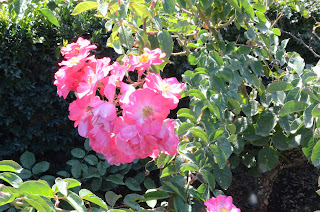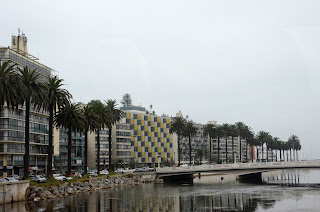As we travelled between one winery and the other, we saw some interesting sights. These two were riding along the narrow road beside the bus, and I was able to photograph them through the window.
We were encouraged to admire these old walls, some of the few traditional constructions of stone, plaster and tile that remain along the road.
 |
| The 'pan' sign means that fresh bread is for sale. |
Our destination for this beautiful afternoon was a second winery, Concho y Toro, said to be one of the most important and productive in Chile. It was founded in 1883, and is located near Pirque. Here, we had a tour of the estate, the vineyard, and the winery before our tasting.
 |
| Concha y Toro |
 |
| Enjoying the shade of the towering trees |
 |
| One wing of the estate house, now used for business offices |
 |
| There was a special area of the vineyard for guests, with different varieties of grapes for tasting. They were sweet and flavorful, and quite different, one from another. |
 |
Casillero del Diablo Cabernet Sauvignon
 |
| The cellars of El Diablo, celebrating the story of the Casillero del Diablo Cabernet Sauvignon |
 |
| "King Jim" welcomed us to the tasting room. |
 |
| His domain reaches all the way to Ohio. |
We enjoyed the tour, but found their wines to be more robust than we care for.
Driving home, we were able to see some more of the city of Santiago. The city has a population of almost 5 million people, and we saw large modern suburbian housing developments.
As we approached the city again, we saw many examples our what our guide referred to as 'mushroom houses' - tiny houses thrown together by the poor in any small space that became available.
 |
| Quite a change from the older, traditional homes, or the ranch style of the older suburbs. |
The tunnels, one of which ran under the river, kept us out of the worst of the traffic approaching the heart of the city. The tunnels were from one to four miles long.
In the city itself, we saw beautiful old European-style homes and buildings, similar to those in the other cities we had visited. All these shots were taken from the bus window.
Our last dinner together was a lovely one, at a restaurant opened just for us. Teresa gave out a few little awards, and our friend, Carole, from Oklahoma, had us all laughing again when she complained, "If I had known there were going to be prizes, I would have worked harder!" George and Carolyn celebrated their wedding anniversary and Karen, her birthday, so there were toasts all around for these occasions, and to the end of our tour.
 |
| This beautiful church had been built around an old church, and one ancient window was visible - the remnant of the oldest church in Santiago. |
 |
| The cathedral square, late on Sunday afternoon. I liked the speed bumps at the sides of the traffic lane to protect people in the square. |
 |
| Lots of people on one the streets adjacent to the cathedral. |
 |
| Carole, Elaine, George, Fred |
 |
| Chocolate sticky pudding, topped with chocolate and a caramel sauce for a decadent dessert! |
We would spend our last day at the Estancia El Pregon and then head to the airport for evening departures.































































